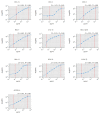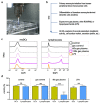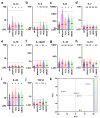Argon Plasma Exposure Augments Costimulatory Ligands and Cytokine Release in Human Monocyte-Derived Dendritic Cells
- PMID: 33917526
- PMCID: PMC8038845
- DOI: 10.3390/ijms22073790
Argon Plasma Exposure Augments Costimulatory Ligands and Cytokine Release in Human Monocyte-Derived Dendritic Cells
Abstract
Cold physical plasma is a partially ionized gas expelling many reactive oxygen and nitrogen species (ROS/RNS). Several plasma devices have been licensed for medical use in dermatology, and recent experimental studies suggest their putative role in cancer treatment. In cancer therapies with an immunological dimension, successful antigen presentation and inflammation modulation is a key hallmark to elicit antitumor immunity. Dendritic cells (DCs) are critical for this task. However, the inflammatory consequences of DCs following plasma exposure are unknown. To this end, human monocyte-derived DCs (moDCs) were expanded from isolated human primary monocytes; exposed to plasma; and their metabolic activity, surface marker expression, and cytokine profiles were analyzed. As controls, hydrogen peroxide, hypochlorous acid, and peroxynitrite were used. Among all types of ROS/RNS-mediated treatments, plasma exposure exerted the most notable increase of activation markers at 24 h such as CD25, CD40, and CD83 known to be crucial for T cell costimulation. Moreover, the treatments increased interleukin (IL)-1α, IL-6, and IL-23. Altogether, this study suggests plasma treatment augmenting costimulatory ligand and cytokine expression in human moDCs, which might exert beneficial effects in the tumor microenvironment.
Keywords: CAP; RNS; ROS; cancer; cold atmospheric pressure plasma; hydrogen peroxide; hypochlorous acid; moDCs; peroxynitrite; reactive oxygen and nitrogen species.
Conflict of interest statement
The authors declare no conflict of interest. The founding sponsors had no role in the design of the study; in the collection, analyses, or interpretation of data; in the writing of the manuscript; or in the decision to publish the results.
Figures





Similar articles
-
Modulation of Proinflammatory Cytokines in Monocyte-Derived Dendritic Cells by Porcine Reproductive and Respiratory Syndrome Virus Through Interaction with the Porcine Intercellular-Adhesion-Molecule-3-Grabbing Nonintegrin.Viral Immunol. 2016 Dec;29(10):546-556. doi: 10.1089/vim.2016.0104. Epub 2016 Sep 19. Viral Immunol. 2016. PMID: 27643915
-
Patient-Derived Human Basal and Cutaneous Squamous Cell Carcinoma Tissues Display Apoptosis and Immunomodulation following Gas Plasma Exposure with a Certified Argon Jet.Int J Mol Sci. 2021 Oct 23;22(21):11446. doi: 10.3390/ijms222111446. Int J Mol Sci. 2021. PMID: 34768877 Free PMC article.
-
Elevated level of pro inflammatory cytokine and chemokine expression in chicken bone marrow and monocyte derived dendritic cells following LPS induced maturation.Cytokine. 2016 Sep;85:140-7. doi: 10.1016/j.cyto.2016.06.022. Epub 2016 Jun 23. Cytokine. 2016. PMID: 27344111
-
Diverse functional activity of CD83+ monocyte-derived dendritic cells and the implications for cancer vaccines.Crit Rev Immunol. 2001;21(1-3):157-78. Crit Rev Immunol. 2001. PMID: 11642602 Review.
-
Medical gas plasma technology: Roadmap on cancer treatment and immunotherapy.Redox Biol. 2023 Sep;65:102798. doi: 10.1016/j.redox.2023.102798. Epub 2023 Jun 27. Redox Biol. 2023. PMID: 37556976 Free PMC article. Review.
Cited by
-
Current State of Cold Atmospheric Plasma and Cancer-Immunity Cycle: Therapeutic Relevance and Overcoming Clinical Limitations Using Hydrogels.Adv Sci (Weinh). 2023 Mar;10(8):e2205803. doi: 10.1002/advs.202205803. Epub 2023 Jan 20. Adv Sci (Weinh). 2023. PMID: 36670068 Free PMC article. Review.
-
Exploratory Research for HIF-1α Overexpression Tumor Antigen in the Activation of Dendritic Cells and the Potent Anti-Tumor Immune Response.Cancer Manag Res. 2024 Dec 17;16:1813-1822. doi: 10.2147/CMAR.S482363. eCollection 2024. Cancer Manag Res. 2024. PMID: 39713567 Free PMC article.
-
In-Vitro Biofilm Removal Efficacy Using Water Jet in Combination with Cold Plasma Technology on Dental Titanium Implants.Int J Mol Sci. 2023 Jan 13;24(2):1606. doi: 10.3390/ijms24021606. Int J Mol Sci. 2023. PMID: 36675120 Free PMC article.
-
Modulation of the Tumor-Associated Immuno-Environment by Non-Invasive Physical Plasma.Cancers (Basel). 2023 Feb 8;15(4):1073. doi: 10.3390/cancers15041073. Cancers (Basel). 2023. PMID: 36831415 Free PMC article. Review.
-
Murine Macrophages Modulate Their Inflammatory Profile in Response to Gas Plasma-Inactivated Pancreatic Cancer Cells.Cancers (Basel). 2021 May 21;13(11):2525. doi: 10.3390/cancers13112525. Cancers (Basel). 2021. PMID: 34064000 Free PMC article.
References
-
- Immenschuh S., Schroder H. Heme oxygenase-1 and cardiovascular disease. Histol. Histopathol. 2006;21:679–685. - PubMed
MeSH terms
Substances
Grants and funding
LinkOut - more resources
Full Text Sources
Other Literature Sources
Research Materials
Miscellaneous

